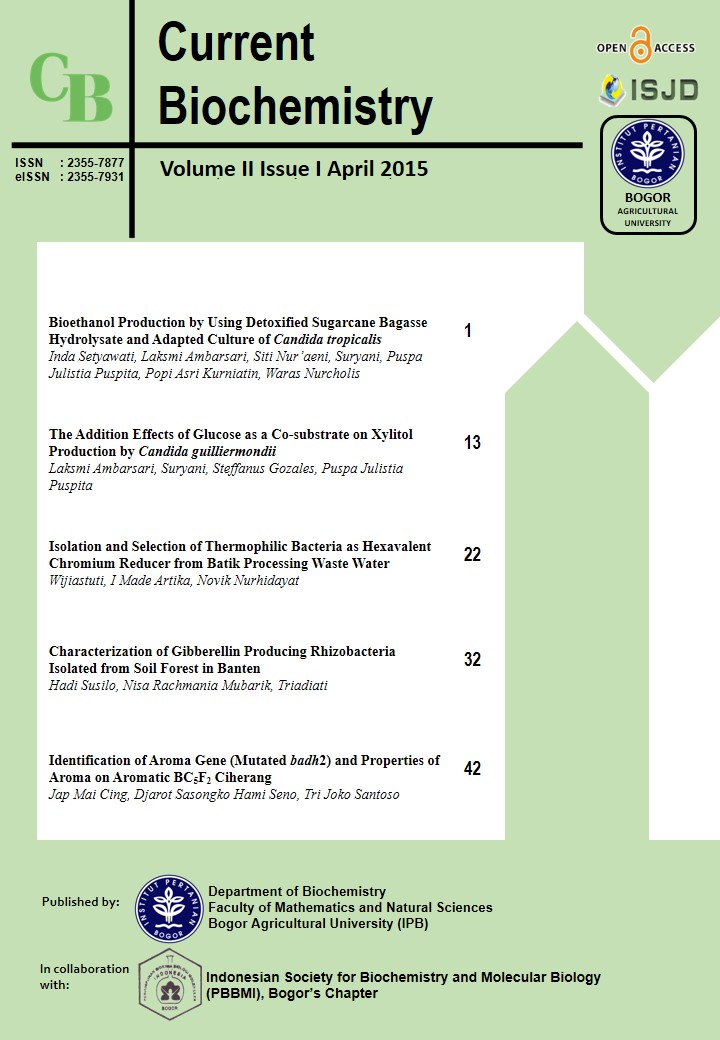Characterization of Gibberellin Producing Rhizobacteria Isolated from Soil Forest in Banten
Abstract
Gibberellin is plant growth regulator that stimulates cell elongation, seed germination, flowering, and fruit ripening. This study was conducted to isolate, identify, and optimize growth media for gibberellins producing- rhizobacteria isolated from rhizosphere soil of “keruing“ (Dipterocarpus sp.) tree in forest research Carita, Pandeglang, Banten. Eight bacterial isolates were obtained and all produced gibberellin. The BC2 isolate produced the highest of gibberellin (0.897 mg mL-1) and then selected for identification based on physiology, molecular character, and effects of growth media with variation of temperature, pH, and light. The result of physiological test indicated that BC2 isolate does not produce indole, positive on urease and oxidative carbohydrate. The phylogenetic analysis showed that BC2 isolate is belonged to Stenotrophomonas maltophilia with 98% similarity level. The optimation of growth media indicated that the growth of BC2 isolate was optimum at 30°C, pH 7, and dark condition.References
Ahmad F, Ahmad I, Khan MS. 2008. Scr eening of free-living rhizosphere bacteria for their multiple plant growth promoting activities. Microbiol Res. 163:173-181.
Altschul SF, Madden TL, Schaffer AA, Zhang J, Miller W. 199 7. Gapped BLAST and PSI-BLAST: a new generation of protein database search programs. Nucleic Acids Res. 25:3389-3402.
Arruda L, Beneduzi A, Martins A, Lisboa B, Lopes C, Bertolo F, Passaglia LMP, Vargas LK. 2013. Screening of rhizobacteria isolated from maize (Zea mays L.) in Rio Grande do Sul State (South Brazil) and analysis of their potential to improve plant growth. Appl Soil Ecol. 63: 15-22.
Atzorn R, Crozier A, Wheeler C, Sandberg G. 199 8. Production of gibberellin and indole 3-acetic acid by Rhizobium phasseoli in relation to nodulation of Phaseolus vulgaris roots. Planta. 175(9):532-538.
Bandelier S, Renaud R. 199 7. Production of gibberellic acid by fed-batch solid state fermentation in aseptic pilot scale reactor. Proc Biochem. 32(4):141-145.
Bottini R, Fulchieri M, Pearce D, Pharis RP. 1989. Identification of gibberellin A1, A3, and isoA3, in culture of Azospirillium lipoferum. Plant Physiol. 90(7):45-47.
Bomke C, Tudzynki B. 2009. Diversity, regulation and evolution of the gibberellins biosynthetic pathway in fungi compared to plants and bacteria. Phytochemistry. 70(9):1876.
Broeckling CD, Broz AK, Bergelson J, Manter DK, Vivanco JM. 2008. Root exudates regulate soil fungal community composition and diversity. Appl Environ Microbiol. 18(8):738-744.
Broun-Howland EB, Danielsen SA, Niezwicki-Bouer SA. 199 2. Development of rapid method for detecting bacterial cell in situ using 16S rRNA targeted probes. Biotechnique. 13(7):928-933.
Fernie AR, Willmitzer L. 2001. Molecular and biochemical triggers of potato tuber development. Plant Physiol. 127(12):1459-1465.
Gunes A, Turan M, Gulluce M, Sahin F. 2013. Nutritional content analysis of plant growth-promoting rhizobacteria species. Eur J Soil Biol. 60:88-97.
Goldberg-Moeller R, Shalom L, Shlizerman L, Samuels S, Zur N, Ophir R, Blumwald E, Sadka A. 2013. Effect of gibberellins treatment during flowering induction period on global gene expression and the transcription of flowering-control genes in Citrus buds. Plant Sci. 198:46-57.
Gomi K, Matsuoka M. 2003. Gibberellin signaling pathway. Curr Opin Plant Biol. 6(4): 489-493.
Hyde DK, Aung S, Jeewon R, Pointing BS. 2009. Diversity and abundance of nematode-trapping fungi from decaying litter in terrestrial freshwater and mangrove habitats. J Biodivers Conserv. 18:1695-1714.
Karakoc S, Aksoz N. 2006. Some optimal cultural parameter for gibberellic acid biosynthesis by Pseudomonas sp. Turk J Biol. 30(7):81-85.
Kang SM, Khan AL, Waqas M, You YH, Haamayun M, Joo GJ, Shahzad R, Choi KS, Lee IJ. 2015. Gibberellin-producing Serratia nematodiphila PEJ1011 ameliorates low temperature stress in Capsicum annum L. Eur J Soil Biol. 30:1-9.
Kumar A, Maurya BR, Raghuwanshi R. 2014. Isolation and characterization of PGPR and their effect on growth, yield and nutrient content in wheat (Triticum aesticum L.). Biocat agri Biotech. 3:121-128.
Lebuhn M, Heulin T, Hartman A. 199 7. Production of auxin and other indolic and phenolic compounds by Phaenibacillus polymixa strains isolated from different proximity to plant root. FEMS Microbiol Ecol. 22:325-334.
Lindsay WP, Lamb CJ, Dixon RA. 199 3. Microbial recognition and activation of plant defence system. Trends Microbiol. 5(1):181-187.
MacMillan J. 2002. Occurence of gibberellins in vascular plants, fungi, and bacteria. J Plant Growth Reg. 20(6):387-443.
Marchesi JR, Sato T, Weightman AJ, Martin TA, Fry JC, Hiom SJ, Wade WG. 199 8. Design and evaluation of useful bacterium-specific PCR primer that amplify genes coding for bacterial 16S rRNA. Appl Environ Microbiol. 64(2):796-799 .
Miransari M, Smith D. 2014. Plant hormone and seed germination. Environ Exp Bot. 99 :110-121.
Palleroni NJ. 1984. Practical Handbook of Microbiology. Edisi ke-2. Baltimore: William & Wilkin.
Palleroni NJ, Bradbury JF. 199 3. Stenotrophomonas, a New bacterial genus for Xanthomonas maltophilia (Hugh 1980). Int J Syst Bacteriol. 43(3): 606-609.
Riberio CM, Cardoso EJBN. 2012. Isolation, selection and characterization of root-associated growth promoting bacteria in Brazil pine (Araucaria angustifolia). Microbiol Res. 167(10):60-78.
Shruti K, Arun K, Yuvneet R. 2013. Potential plant growth-promoting activity of rhizobacteria Pseudomonas sp. in Oryza sativa. J Nat Prod Plant Resour. 3(4):38-50.
Unyayar S, Topcuoglu SF, Unyayar A. 199 6. A modified methods for extraction and identification of indol-3-acetic acid (IAA), gibberellins acid (GA3), abscicid acid (ABA) and zeatin product by Phanerochate chrysosporium. Bulg J Plant Physiol. 22(3-4):105-110.
Vanneste JL, Paulin JP, Expert D. 199 0. Bacteriophage as a genetic tool to study Erwinia amylovora pathogenicity and hypersensitive reaction on tobacco. J Bacteriol. 172(2): 932-941.










